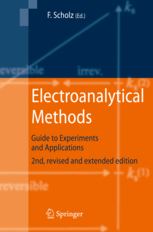 | ||
Electroanalytical methods are a class of techniques in analytical chemistry which study an analyte by measuring the potential (volts) and/or current (amperes) in an electrochemical cell containing the analyte. These methods can be broken down into several categories depending on which aspects of the cell are controlled and which are measured. The three main categories are potentiometry (the difference in electrode potentials is measured), coulometry (the cell's current is measured over time), and voltammetry (the cell's current is measured while actively altering the cell's potential).
Contents
- Electroanalytical techniques ppt by prof dr s jayarama reddy chancellor scsvm former vc svu
- Potentiometry
- Coulometry
- Voltammetry
- Polarography
- Amperometry
- References
Electroanalytical techniques ppt by prof dr s jayarama reddy chancellor scsvm former vc svu
Potentiometry
Potentiometry passively measures the potential of a solution between two electrodes, affecting the solution very little in the process. One electrode is called the reference electrode and has a constant potential, while the other one is an indicator electrode whose potential changes with the composition of the sample. Therefore, the difference of potential between the two electrodes gives an assessment of the composition of the sample. In fact, since potentiometric measurements in a non-destructive measurement, assuming that the electrode is in equilibrium with the solution we are measuring the potential of the solution. Potentiometry usually uses indicator electrodes made selectively sensitive to the ion of interest, such as fluoride in fluoride selective electrodes, so that the potential solely depends on the activity of this ion of interest. The time that takes the electrode to establish equilibrium with the solution will affect the sensitivity or accuracy of the measurement. In aquatic environments Platinum due to its high electron transfer kinetics is often used, although an electrode made from several metals can be used in order to enhance to electron transfer kinetics. The most common potentiometric electrode, by far is the glass-membrane electrode used in a pH meter.
A variant of potentiometry is chronopotentiometry which consists in using a constant current and measurement of potential as a function of time. It has been initiated by Weber
Coulometry
Coulometry uses applied current or potential to completely convert an analyte from one oxidation state to another. In these experiments, the total current passed is measured directly or indirectly to determine the number of electrons passed. Knowing the number of electrons passed can indicate the concentration of the analyte or, when the concentration is known, the number of electrons transferred in the redox reaction. Common forms of coulometry include bulk electrolysis, also known as Potentiostatic coulometry or controlled potential coulometry, as well as a variety of coulometric titrations.
Voltammetry
Voltammetry applies a constant and/or varying potential at an electrode's surface and measures the resulting current with a three electrode system. This method can reveal the reduction potential of an analyte and its electrochemical reactivity. This method in practical terms is nondestructive since only a very small amount of the analyte is consumed at the two-dimensional surface of the working and auxiliary electrodes. In practice the analyte solutions is usually disposed of since it is difficult to separate the analyte from the bulk electrolyte and the experiment requires a small amount of analyte. A normal experiment may involve 1–10 mL solution with an analyte concentration between 1 and 10 mmol/L. Chemically modified electrodes are employed for analysis of organic and inorganic samples.
Polarography
Polarography is a subclass of voltammetry that uses a dropping mercury electrode as the working electrode.
Amperometry
Amperometry is the term indicating the whole of electrochemical techniques in which a current is measured as a function of an independent variable that is, typically, time or electrode potential. Chronoamperometry is the technique in which the current is measured, at a fixed potential, at different times since the start of polarisation. Chronoamperometry is typically carried out in unstirred solution and at fixed electrode, i.e., under experimental conditions avoiding convection as the mass transfer to the electrode. On the other hand, voltammetry is a subclass of amperometry, in which the current is measured by varying the potential applied to the electrode. According to the waveform that describes the way how the potential is varied as a function of time, the different voltammetric techniques are defined. Confusion arose recently about the correct use of many terms proper of electrochemistry/electroanalysis, often owing to the diffusion of electroanalytical techniques in fields where they constitute an instrument to use, not being the 'core business' of the study. Though electrochemists are pleased about this, they invite to use the terms properly, in order to avoid fatal misunderstandings.
